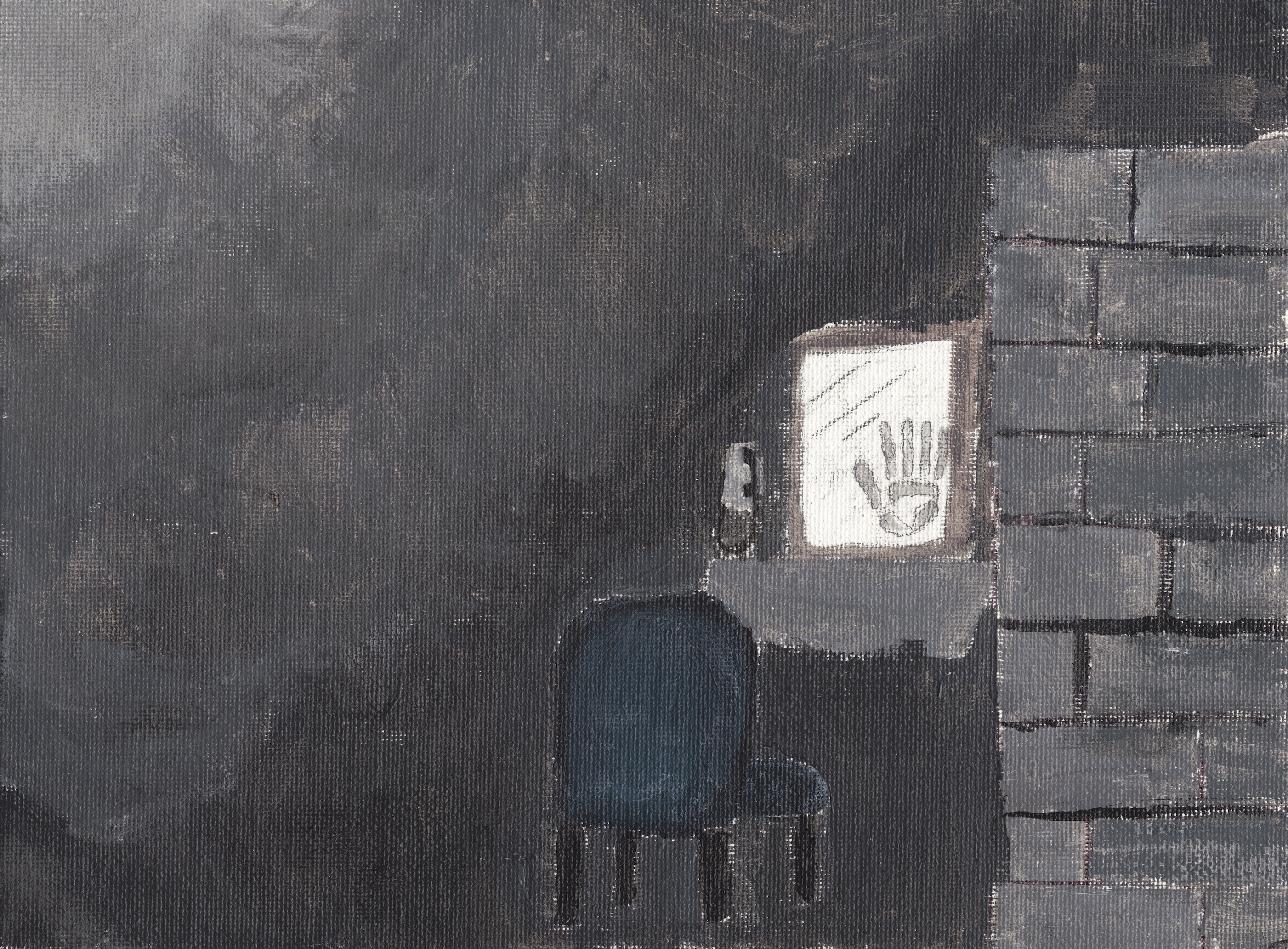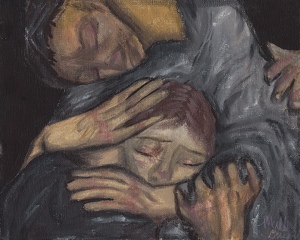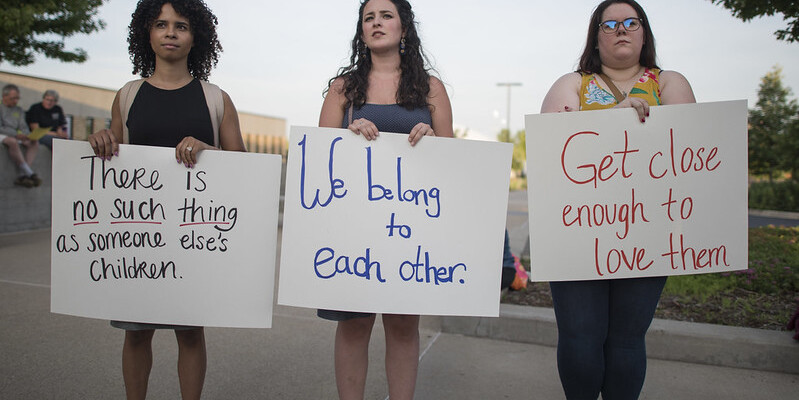On most days, the non-citizens held inside Stewart Detention Center (SDC) outnumber the free population in Lumpkin, Georgia.[1] CoreCivic, the incarceration corporation that owns and operates SDC on behalf of U.S. Immigration and Customs Enforcement (ICE), detains as many as 1,966 immigrants at once. During their detention at SDC, while awaiting decisions on their asylum cases or enforcement of their deportation orders, non-citizens have access to one hour of “non-contact” visitation time each week with friends or family willing and able to travel to this corner of rural Georgia. Lumpkin is a forty-minute drive from the nearest city, Columbus, a little more than a two-hour drive south from Atlanta, and a little less than a two-hour drive east from Montgomery, Alabama. Far from everywhere and without a hotel, or a restaurant open before 11:00 am or after 6:00 pm (2:30 pm on Sunday, Monday, and Tuesday), Lumpkin is a hard place to visit.
When friends and family of the non-citizens inside SDC can travel, El Refugio’s hospitality center provides the only open beds in town. A small immigrant-led staff and many volunteers host visitors in their five-bedroom house.[2] The house often fills on weekends when friends, family, and volunteers take advantage of the SDC visitation protocol that resets the week on Sunday morning. El Refugio encourages visitors to see their loved ones Saturday, enjoy a meal and spend the night at their hospitality center, and then return to SDC on Sunday before driving home. More than just providing a bed and a meal before 11:00 am or after 6:00 pm, El Refugio accompanies families and lays a foundation for affirming community around the isolating, humiliating, and heartbreaking visitation process. When visitors pass through SDC’s gates, they have already left all their belongings, except a “valid, verifiable government-issued identification card,” locked in their car. Then they name their loved one by an ICE-assigned “A-Number,” or alien number, and become subject to a pat-down search or a metal scan.[3] Especially on weekends, visitors may wait hours before prison guards allow them into the visitation area where they speak through a monitored phone and see their loved ones through a window.
Non-contact Visitation and the Accumulating Loss of Family Separation
In 2019, when Luna Rico was twelve years old, she and her mother drove to Lumpkin, locked their belongings in the car, underwent searches, and waited until an SDC prison guard led them to a cold chair, plastic phone receiver, and her stepfather on the opposite side of cloudy glass. A few years later, when her stepfather had returned home, Luna painted her visitation experiences and shared her work with El Refugio.[4] In her painting, Luna transmits in dark tones her sensory memory of reaching out for her stepfather and feeling thick, cold glass under her hand. She paints a less familiar image of family separation, the Trump-era buzzword for incarcerating immigrant parents when they cross the border with their children.[5] Luna’s work transports us hundreds of miles from the border, deep within the rural South, where family separation is also weaponized against immigrant families.

Luna depicts a specific experience of family separation, a primary source unabstracted by newsroom spin or the desire to represent a larger reality through a singular example. The uniqueness of a handprint juxtaposed with the single chair throws into stark relief this family’s separation and blends into the shadowy background the familiar but abstracted concept of any immigrant family separation. The image asks the viewer to recognize the specificity of Luna’s body in that single chair and her hand reaching out and sensing cold, hard glass instead of her stepfather’s warm embrace. By asking us to imagine this scene from the empty room where only her handprint remains, Luna asks us to see the painful residue that family separation leaves behind. Even though her stepfather has returned home, Luna’s art tempers any celebration because the trace of carceral pain still marks the bright spots of this family’s story.
Around the same time and inside the same non-contact visitation room, Mallory Mejía sat across from her father, separated by a monitored telephone and thick glass. A few months after their first visit, Mallory’s father received his deportation order. His family drove to Lumpkin to see him one last time and then he boarded a flight to Honduras. Years later, Mallory created home can be a person, too, a painting that depicts in a darkened hue a moment that never happened: Mallory and her father’s last hug to say goodbye.[6]

In an interview about the painting, Mallory shared that the brush strokes reach down because she let her emotions flow from her hands to the canvas.[7] She traced her sadness to convey that the family in the image is about to be separated. When asked about the title’s origin, Mallory explained that it comes from the feeling that “…everyone has a home or, kind of, a comfort place that they can go to. And for me, that was my dad. So, I think that home can be a person, too really means just like, your home can be more than just, you know, four walls and a roof. It can be a person that you go to for comfort and for love.” When he was arrested, detained, separated from his daughter across a thick glass panel, and forced to return to Honduras, Mallory’s father lost his home. But Mallory wants her viewer to know that when immigrants are forced to leave, those who remain lose their homes, too.
When we spoke about her painting, Mallory insisted that she is a regular teenager “going through things that most teenagers go through.” She plays basketball and volleyball, she likes to paint and draw (but not as much as she likes sports), and she lost her father to deportation. Mallory explained that she shared her painting with El Refugio because she hopes to circulate it as widely as possible; she wants her friends and other kids to know that “…you’re not alone in this situation. So many people go through this.” For Mallory, making and sharing art about her family’s separation is meant to materialize identification and accompaniment through the non-exceptional, devastatingly common experience of losing home to immigration enforcement policy. Together, Luna’s and Mallory’s paintings make visible images that cannot materialize in any other way. As they show us the ways that family separation, whether temporary or permanent, continues to mark their life stories, they paint the real spaces and impossible moments that anchor so many other painful, non-contact visitation memories.
Those Who Remain
Through years of hospitality and accompaniment, Amilcar Valencia, El Refugio’s executive director, has archived in his memory events that have gone unrecorded inside the walls that Luna painted. Once, after a young child learned that the prison guards hold the keys to locked doors and gates, they walked straight up to the nearest uniformed official and asked if his key would let their dad go. Amilcar has listened compassionately as families and volunteers recount the sounds of children’s fists banging against thick glass, demanding their lost shares of hugs, playtime, and bursts of laughter. Maybe, like Mallory, those children imagine unrealized moments with mental brushstrokes. Do they see their fathers throwing them in the air and conjure their delight in the trust that open arms break the fall every time? The art of children who remain on the free side of non-contact of visitation or in the places that no longer feel like homes anchors immigration incarceration testimony, from all sides, in material representations of the unphotographable spaces and unlivable moments of this enduring, reiterating violence.
We share their art here to honor Luna’s and Mallory’s desires to amplify their violent encounters with non-contact visitation, an additional layer of family separation that has heightened their already painful, confusing experiences with immigration incarceration. Ultimately, instituting a non-contact visitation protocol is a local decision; the ICE Detention Standard instructs individual facilities to permit, or not, contact visits based on the “physical plant and detainee population.”[8] In the early 2000s, CoreCivic (formerly Corrections Corporation of America) designed and constructed the SDC building with the expressed intention to operate a non-criminal incarceration facility for immigrants detained by ICE. The divided visitation room, with monitored phones and thick glass windows, was always part of the facility’s design. The SDC building was not adapted from an existing structure or repurposed to fill an urgent need. CoreCivic, empowered by ICE, anti-immigrant legislation, and tax dollars, built SDC with a wall in between non-citizens and their families.
Non-contact visitation is one among many harm-inducing policies and practices that have made SDC one of the deadliest immigration detention facilities in the country.[9] As of October 2023, eleven people have died while detained, including 61-year-old Salvador Vargas,[10] 44-year-old Pedro Arriago Santoya,[11] and 40-year-old Efraín Romero de la Rosa.[12] These deaths exemplify the neglectful medical care and health and safety standards evident in the Department of Homeland Security’s self-inspection and numerous non-governmental reports including El Refugio’s Cage of Fear, multiple sexual assault complaints against SDC nurses, and Project South’s forced labor complaint on behalf of three people formerly detained at SDC. When non-citizens, their families, and their advocates find avenues to speak out, the widely reaching, intentional cruelty of immigration incarceration becomes even more difficult to ignore or deny.
As these reports enumerate and call out deplorable detention conditions, art inspired by experiences inside SDC’s walls challenges the totalizing power of immigration incarceration. What young artists create from their encounters with inhospitality, degraded humanity, and the denial of their families, they assert art as a defense strategy, a powerful weapon to fight against the narratives, concrete walls, and thick glass windows that isolate them from their loved ones and each other. Art like Luna’s and Mallory’s bends the iron gates, opens the locked doors, and guards their flesh against the razor-wire fences that seal their stories inside cold, dark visitation rooms at the end of rural country highways. Having been entrusted with Luna’s and Mallory’s beautifully materialized stories, we share them here and as widely as possible so that they speak to you, in their own voices, about the enduring, accumulating, and broad reach of immigrant family separation.
May-June 2024 Series on Deportation and Coerced Return curated by Professor Perla M. Guerrero and Professor Gretel H. Vera Rosas.
Featured Photo: Lights for Liberty: A Vigil to End Human Detention Camps. July 12, 2019. St. Paul, Minnesota. Photo by Fibonacci Blue on Flickr. CC BY 2.0
Notes
[1] “Lumpkin City, Georgia,” US Census Bureau, 2020. https://data.census.gov/profile/Lumpkin_city,_Georgia?g=160XX00US1347980.
[2] Full Frontal with Samantha Bee donated the house to El Refugio in 2018 so that they could upgrade their 2-bedroom, 1-bathroom rental. Read more in the Atlanta Journal-Constitution.
[3] “Stewart Detention Center, Atlanta Field Office,” US Immigration and Customs Enforcement, https://www.ice.gov/detain/detention-facilities/stewart-detention-center.
[4] Thank you to El Refugio staff member, Patti Ghezzi, for interviewing Luna and her family.
[5] Family separation became a buzzword to name the consequences of the Trump administration’s “zero tolerance” policy for undocumented entry from Mexico into the US. When then-Attorney General Jeff Sessions announced the policy, he laid the groundwork for assuming that parents crossing with their children are “smuggling” them into the U.S. See a clip of the speech here: KPIX CBS News Bay Area, May 7, 2018.
[6] Mallory submitted home can be a person, too in response to a call to contribute to Breaking Out: Immigrant Art from Stewart Detention Center, an exhibition featuring art and letters created by non-citizens detained at SDC. Mallory’s was the only piece created outside SDC. Breaking Out was curated by Kristen Kolenz in collaboration with El Refugio as a part of “Rethinking the Dynamic Interplay of Migration, Race, and Ethnicity in the Caribbean and Latin America,” the 2021-23 Mellon Sawyer Seminar at the Brown University Center for Latin American and Caribbean Studies.
[7] Mallory Mejía (and Lori Mejía), virtual interview with Kristen Kolenz, March 2022.
[8] “ICE/DRO Detention Standard: Visitation,” ICE.gov, December 2, 2008, https://www.ice.gov/doclib/dro/detention-standards/pdf/visitation.pdf.
[9] Rebekah Wolf, “A Closer Look at Deaths in ICE Detention Facilities,” Immigration Impact, April 13, 2023, https://immigrationimpact.com/2023/04/13/a-closer-look-at-deaths-in-ice-detention-facilities/ Immigration Impact is a project of the American Immigration Council, a non-profit immigration justice organization focused on research, legal advocacy, and public education.
[10] “SPLC Statement on Latest Death at Stewart Detention Center,” SPLCenter.org, April 7, 2023, https://www.splcenter.org/presscenter/splc-statement-latest-death-stewart-detention-center.
[11] Georgia Latino Alliance for Human Rights, “To Our Loved Ones: Honoring Pedro and Others Who Died in Detention,” GLAHR.org, February 2020, https://glahr.org/simple-event/community-meetings-every-monday-2/.
[12] Jose Olivares, “ICE Review of Immigrant’s Suicide Finds Falsified Documents, Neglect, and Improper Confinement,” The Intercept, October 23, 2021. https://theintercept.com/2021/10/23/ice-review-neglect-stewart-suicide-corecivic/.

